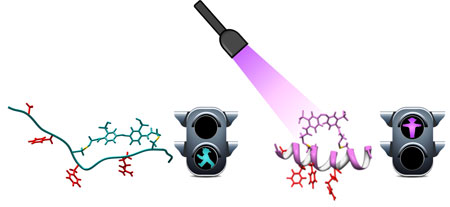| Jun 18, 2013 |
Pioneering breakthrough of chemical nanoengineering to design drugs controlled by light
|
|
(Nanowerk News) The scientific cooperation between chemists, biotechnologists and physicists from various Catalan institutes, headed by Pau Gorostiza, from the Institute for Bioengineering of Catalonia (IBEC), and Ernest Giralt, from the Institute for Research in Biomedicine (IRB Barcelona), has led to a breakthrough that will favor the development of light-regulated therapeutic molecules. The breakthrough published online today in the German journal of reference in chemistry Angewandte Chemie ("Light-Regulated Stapled Peptides to Inhibit Protein–Protein Interactions Involved in Clathrin-Mediated Endocytosis") has received recognition as a “Very Important Paper”, a distinction that only 5% of the articles accepted achieve. Moreover, the paper will feature on the cover of the July issue.
|
 |
| Control of membrane traffic: Photoswitchable inhibitors of protein–protein interactions were applied to photoregulate clathrin-mediated endocytosis (CME) in living cells. Traffic light (TL) peptides acting as “stop” and “go” signals for membrane traffic can be used to dissect the role of CME in receptor internalization and in cell growth, division, and differentiation.
|
|
The “Design, synthesis and structure of peptides and proteins” lab headed by Dr. Giralt, also senior professor at the University of Barcelona and holder of the 2011 Spanish National Research Prize, has synthesized two peptides (small proteins), which, on irradiation with light, change shape, thereby allowing or preventing an specific protein-protein interaction. The association of these two proteins is required for endocytosis, a process by which cells allow molecules to cross the cell membrane and enter. The Italian scientist Laura Nevola, postdoctoral researcher who works in Dr. Giralt’s lab, and Andrés Martín-Quirós, a PhD student with Dr. Gorostiza’s lab, co-authors of the study, have spent four years working on the design of photo-sensitive peptides.
|
|
“Photo-sensitive peptides act like traffic lights and can be made to give a green or red light for cell endocytosis. They are powerful tools for cell biology,” explains Dr. Giralt. “These molecules allow us to use focalized light like a magic wand to control biological processes and to study them,” adds the physicist Pau Gorostiza, ICREA professor, and head of the “Nanoprobes and nanoswitches” lab at IBEC.
|
|
The researchers highlight the immediate applicability of these molecules to study, for example, in vitro endocytosis in cancer cells –where this process is uncontrolled– which would allow selective inhibition of the proliferation of these cells. Also, they would also allow the study of developmental biology –where cells require endocytosis to change shape and function, processes that are orchestrated with great spatial and temporal precision. In this context, photo-sensitive peptides will allow the manipulation of the complex development of a multicellular organism by means of light patterns. “ In view of the results, we are now working towards a general recipe to design photo-switchable inhibitory peptides that can be used to manipulate other protein-protein interactions inside cells by applying light,” explain the researchers.
|
|
Towards optopharmacology or therapeutic molecules regulated by light
|
|
“This first breakthrough will allow us to generate the same kind of peptides for chemical-medical applications,” says Giralt. Dr. Gorostiza was the person who came up with the idea of manipulating biological and pharmacological processes through the use of light after spending five years specializing in this field at the University of California in Berkeley. The coordinator of the ERC Starting Grant project “OpticalBullet” and of the ERC Proof of Concept “Theralight”, both involving collaboration with Giralt’s lab, explains that, “the most immediate therapeutic applications we can expect is for diseases affecting superficial tissue such as the skin, the retina and the most external mucosal membranes.”
|
|
The modification of biological processes by means of light is leading to the development of cutting-edge tools for biology and medicine and opening up new research fields, such as optopharmacology and optogenetics. The combination of drugs with external devices to control light may contribute to the development of personalized medicine in which treatments can be adapted to each patient, limiting the time given regions are treated, thus markedly reducing unwanted effects.
|
|
Improvements in lasers and chemical engineering
|
|
To work towards the development of photo-sensitive drugs, we must enhance the photochemical response of the compounds and be able to stimulate them at visible wavelengths. “Prolonged illumination with ultraviolet light is toxic for cells and is therefore a clear limitation as well has having little tissue penetration capacity,” Giralt explains as an example. Furthermore, the photo-conversion of the compounds needs to be improved as does their stability in the dark in order to be able to “on demand, design them in such a way that they relax rapidly when irradiation with light stops or that they “remember” for hours or days the light stimulation received,” adds Gorostiza.
|
|
This study has also involved the collaboration of researchers with IRB Barcelona’s Advanced Digital Microscopy Platform, who designed an adhoc programme to be able to qualitatively and quantitatively validate the effects of the peptides inside the cells in real time. Similarly, in the field of biology, the team has been supported by Dr. Artur Llobet’s group at IDIBELL.
|

